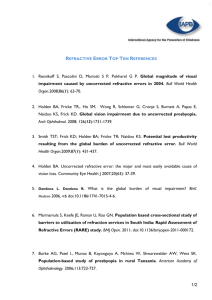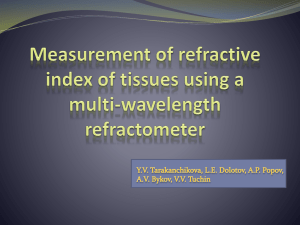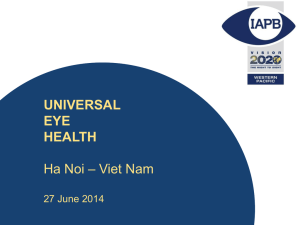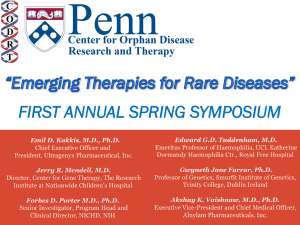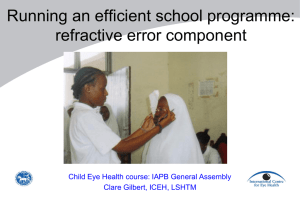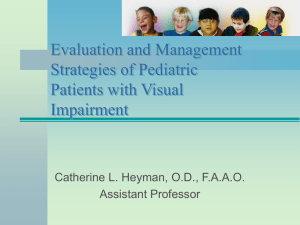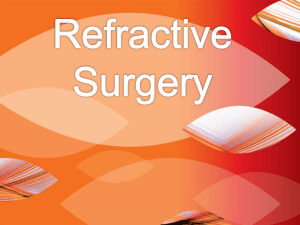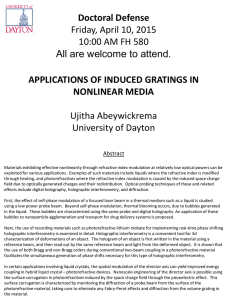RAPID ASSESSMENT OF REFRACTIVE ERROR (RARE)
advertisement
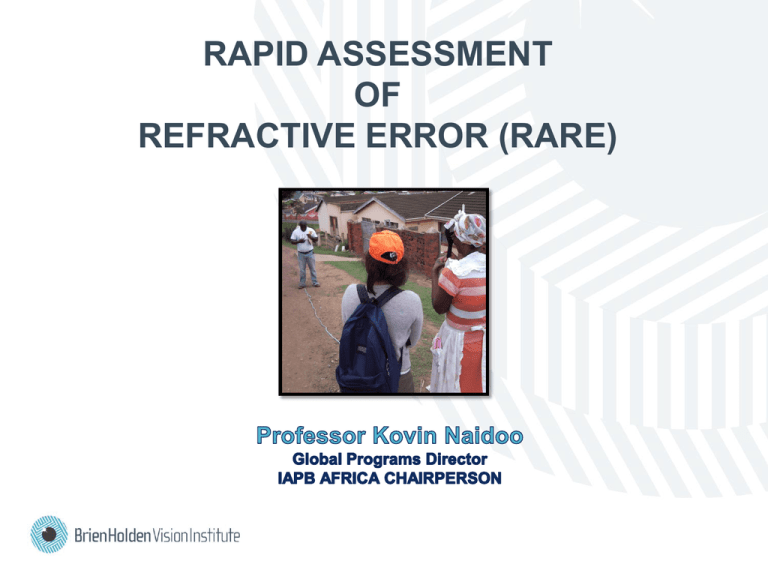
RAPID ASSESSMENT OF REFRACTIVE ERROR (RARE) Uncorrected Refractive Error (URE) “The Crisis” • URE is most common cause of Visual impairment (VI) worldwide and 2nd most common cause of blindness1,2 • URE drives children and adults further into poverty:3 − Limits opportunities to education − Employment − Seriously impacts quality of life and productivity • Link between poverty and VI due to URE places heavy economic burden on individuals families affected nations What is the status of URE?4 Prevalence of Visual Impairment • 158 million cases of Distance VI • 544 million cases of Near VI Human Resources Required • 47000 full-time refractionists • 18000 ophthalmic dispensers Cost of Human Resource Development Implications • US $20-28 billion Implications Estimated loss in global GDP due to DVI US $ 202 billion Historical Situation • Paucity of Data • Refractive data elicited through: − RESC studies • From community to school • Children only − Conventional Population based studies • • • • Prohibitively expensive High level of expertise Few and far between Lag between completion and Program implementation timelines CONTEXT SETTING • Why and where do we need data − National level • • • • Planning Evaluation Awareness Advocacy − Regional level • Advocacy • Establish priorities for investment in regions RARE Evolved out of RACSS and RAABS Rapid Quick Cost effective Assessment Simple Results Refractive Error Prevalence Barriers How does RARE data help? • RARE data can be used in a top-down or bottom-up approach. TOP-DOWN Globally 285.389 mil VI 246.024 mil Blind Regional RARE RARE STUDIES RARE STUDIES LOCATE Blind and VI EXPAND to the national or even global context BOTTOM-UP METHODOLOGY Target Group • RARE studies used to assess prevalence of URE, presbyopia, spectacle coverage, and barriers to uptake of services for refractive errors and presbyopia5 Studies are focused on: • Younger age groups more affected by RE • Presbyopia • 15-49 years Definitions Condition Visual Impairment Definition Binocular Presenting VA<6/12 in the better eye Uncorrected Refractive Presenting VA<6/12 but improving Error (URE) Presbyopia ≥6/12 with pinhole Binocular near vision < N8 at 33-35cms Definitions Definition URE Description Unaided VA <6/12 but improving to 6/12 or (Unmet need) better with pinhole and no spectacles Uncorrected Binocular Unaided near vision <N8 in Presbyopia subjects aged >35 years with no distance VI (Unmet need) and no spectacles Corrected RE Unaided VA<6/18 but improved to 6/18 or (Met need) Corrected Presbyopia (Met need) better with spectacles Unaided near vision < N8, but improved to N8 or better with their spectacles RARE Toolkit Equipment Purpose Snellen chart (E, Alphabet optotypes) Distance Visual Acuity Measuring tape or String Measure testing distance: subject and chart Multiple pinhole occluder Presenting VA, if VA<6/12 N notation chart Near vision Torch light External examination Ready made spectacles (+1.0 to +3.0 Ds) Best corrected near vision assessment in individuals with presbyopia OUTPUTS OF RARE STUDIES Magnitude of RE (uncorrected) Prevalence of presbyopia Spectacle coverage and utilisation patterns Understanding barriers to access of services Provide baseline information Trends in prevalence determined on follow up studies What is the impact of gathering this information? .... Spectacle Coverage [met need’ ] . [(‘met need’ + ‘unmet need’) X 100] Barriers – URE6 35 30.9 30 25 23 20 15 16.5 16.5 Personal reasons Lack of access 12.9 10 5 0 Lack of awareness Lack of felt Economic need reasons Current and future RARE studies • Studies conducted 1. Eritrea 2. Ghana 3. Uganda 4. South Africa 5. Tanzania • Studies in preparation 6. Mozambique 7. Gambia 8. Zambia 9. Cameroon 10. Ethiopia 11. Malawi MAJOR BARRIERS IDENTIFIED IN RARE STUDIES CONDUCTED Affordability of the spectacle exam Aware of problem but felt no need for consultation Unaware of problem Cannot afford the cost of glasses Comparison of visual impairment and refractive error prevalence across various RARE studies 12 10.4 10 8.6 8 6.6 6.4 7 5.7 6 VI RE 4.4 2.9 4 1 1.2 2 0 Eritrea Ghana Uganda Tanzania (South Africa) References 1. Resnikoff S, Pascolini D, Mariotti S, Pokharel P. Global magnitude of visual impairment caused by uncorrected refractive errors in 2004. Bull World Health Organ 2008;86:63-70. 2. Holden BA, Fricke T, Ho S, Wong R, Schlenther G, Cronje S, et al. Global vision impairment due to uncorrected presbyopia. Arch Ophthalmol 2008;126:1731-9. 3. Fricke TR, Holden BA, Wilson DA, Schlenther G, Naidoo KS, Resnikoff S and Frick KD. Global cost of correcting vision impairment from uncorrected refractive error. 4. Naidoo KS, Wallace DB, Holden, BA, Minto H, Faal HB, Dube P. The challenge of uncorrected refractive error: driving the agenda of the Durban Declaration on refractive error and service development. Clin Exp Opt 2010: 93(3): 131-136. 5. Marmamula S, Keeffe JE, Rao GN. Uncorrected refractive errors, presbyopia and spectacle coverage: Results from a Rapid Assessment of Refractive Error survey. Ophthalmic Epidemiology 2009;16:269-74. 6. Marmamula et al. Population-based cross-sectional study of barriers to utilisation of refraction services in South India: Rapid Assessment of Refractive Errors (RARE) Study. British Medical Journal. Acknowledgements • Pirindha Govender • Brien Holden Vision Institute (Public Health Division) – Research Department
